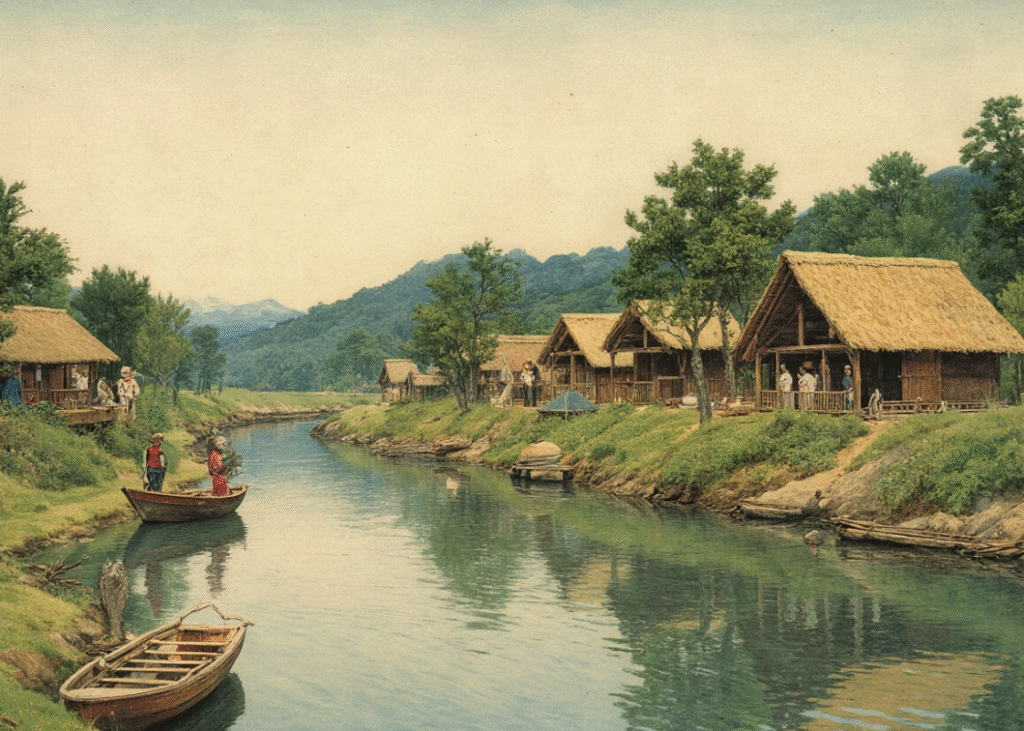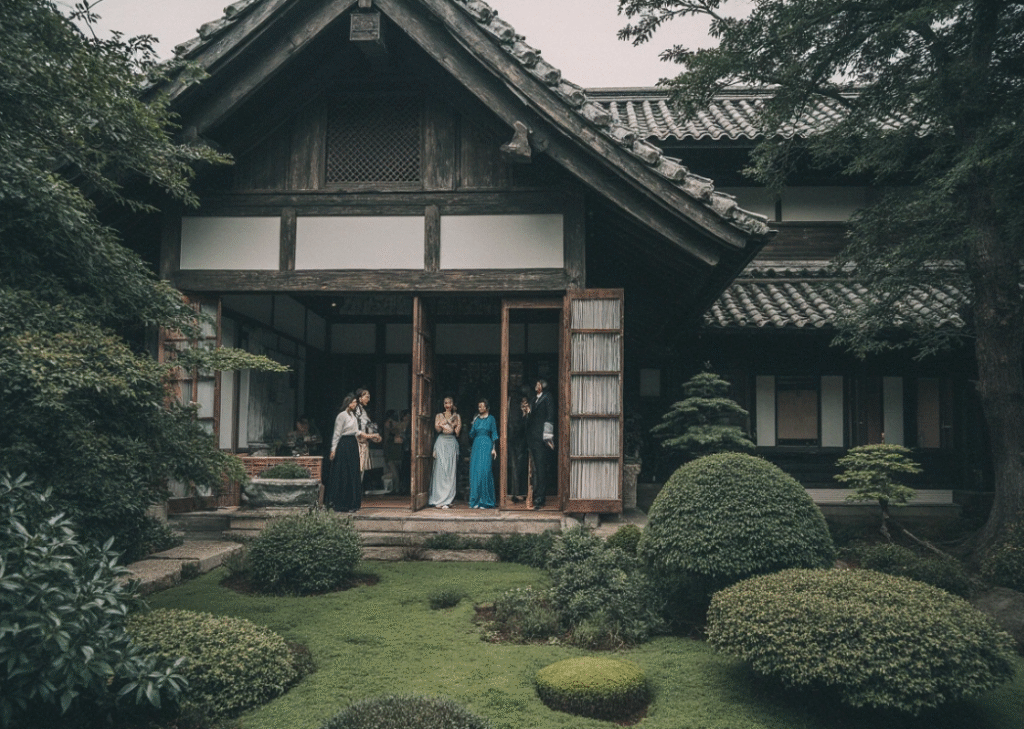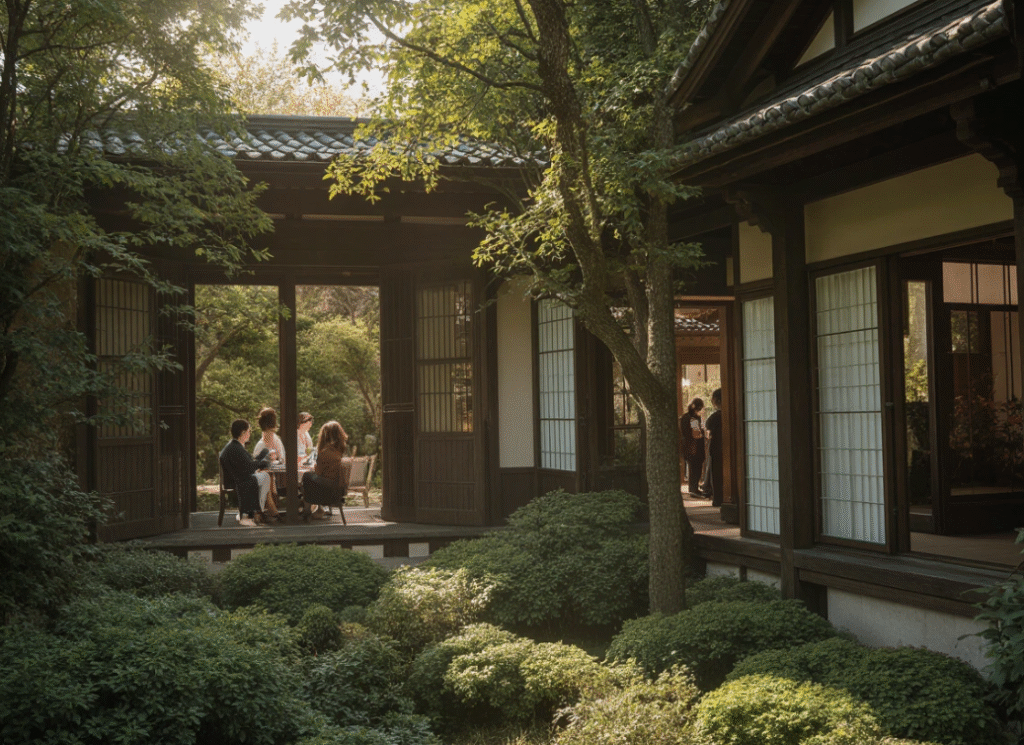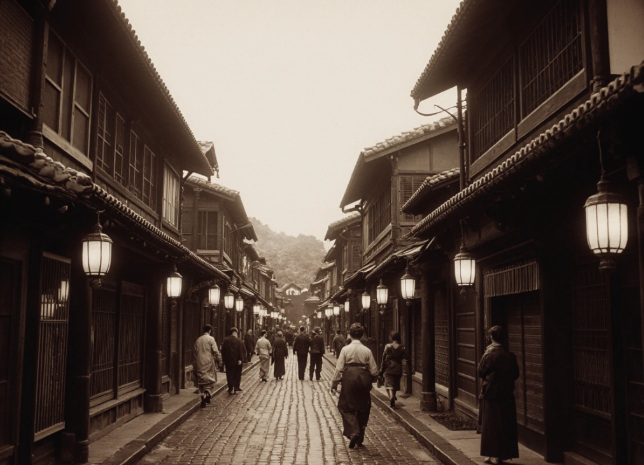Pontocho history begins with an uninhabited sandbar in the Kamo River that transformed into one of Kyoto’s most significant entertainment districts over 350 years. This narrow strip—just 500 meters long and 3-4 meters wide—became a cultural landmark through deliberate urban planning, economic innovation, and adaptation to Japan’s dramatic social changes from the Edo period to today.
More about Pontocho:
Pontocho Origin: How a Sandbar Became Buildable Land
The Pontocho origin story began in 1670 during the Edo period when Kyoto’s municipal government authorized land reclamation along the Kamo River’s western bank. Prior to this, the area was an unstable sandbar that flooded regularly during seasonal rains. City planners reinforced the banks with stone and fill material, creating stable ground for construction.

This wasn’t random development. Kyoto’s economy was recovering from civil war devastation, and the city needed new commercial zones. The shogunate maintained strict zoning laws about where entertainment businesses could operate. This newly reclaimed land existed in a regulatory gray zone—technically part of Kyoto but not subject to the same restrictions as established neighborhoods.
Local merchants recognized the opportunity immediately. Within a decade, the first establishments appeared—primarily teahouses serving travelers and merchants conducting business near the river. The narrow layout proved strategically valuable. It created natural exclusivity and intimacy that broader streets couldn’t offer.
Kyoto Geisha District History: The Economy That Defined Pontocho
Understanding Kyoto geisha district history requires examining how Pontocho received formal designation in 1712 as one of the city’s five official hanamachi (flower towns). This recognition marked its transformation from commercial area to cultural institution. The designation wasn’t merely ceremonial—it was an economic license that shaped the district’s development for the next three centuries.
- The entertainment economy that emerged was sophisticated and hierarchical. Teahouse owners (ochaya) operated as intermediaries between wealthy clients and geiko (Kyoto’s term for geisha). They didn’t employ geiko directly. Instead, they maintained business relationships with okiya (geisha houses) that trained and housed performers. When clients requested entertainment, ochaya would contract geiko from partner okiya, collecting commissions from both parties.
- This created a closed business ecosystem. Entry required substantial capital, established connections, and decades of relationship-building. The result was quality control through social gatekeeping. Only established businesses survived. Only properly trained geiko performed.
- The district developed architectural characteristics that persist today: two-story wooden machiya townhouses with latticed facades, narrow passageways creating acoustic privacy, and rear entrances opening directly onto the Kamo River for discrete access. By the late 1800s, Pontocho hosted over 200 teahouses packed into its narrow footprint—the highest density of entertainment establishments in Kyoto.
Critical Moments That Shaped Pontocho History
The evolution of Pontocho history reveals three existential threats that nearly destroyed the district. The Meiji Restoration of 1868 posed the first challenge when the new government abolished the samurai class—Pontocho’s primary clientele—and initiated aggressive Westernization campaigns. Traditional entertainment fell from favor among the emerging business elite who preferred Western-style establishments.

Pontocho adapted strategically. Teahouse owners began accepting Western businessmen and foreign diplomats as clients. Some introduced chairs and tables for guests uncomfortable with tatami seating. Selected establishments added Western menu items while maintaining traditional kaiseki cuisine. But they refused to compromise core identity elements—geiko training remained traditional, architectural styles stayed unchanged, and the referral-based booking system persisted.
World War II brought physical threats. American bombing raids destroyed much of Kyoto’s infrastructure, but Pontocho survived largely intact due to its narrow layout making it difficult to target from aircraft. The postwar occupation created different challenges when American servicemen flooded Kyoto seeking entertainment, often misunderstanding geiko culture as similar to Western red-light districts.
“The 1950s forced Pontocho to balance economic necessity with cultural preservation. Owners who succeeded treated cultural education as part of the entertainment itself, explaining tea ceremony and traditional arts to foreign visitors who had money but lacked context.”
The most serious modern threat came in 1974 when Kyoto’s municipal government proposed widening the alley to improve traffic flow. Business owners organized collectively to oppose the plan, arguing that the narrow width was the district’s defining characteristic. Their successful resistance established a crucial precedent: the district would resist modernization that compromised its historical character.
From Medieval Guild to Modern Kagai System
Understanding how this entertainment district survived requires examining its unique social structure. The Pontocho Hanamachi functions through layered relationships invisible to outsiders—a system known as kagai (flower world) in traditional Japanese culture.
- At the top are ochaya owners—typically women who inherited businesses through family lines. They maintain relationships with regular clients, some spanning multiple generations. These connections form the district’s social capital.
- Below them are okiya owners who invest years and considerable capital training each geiko in traditional dance, shamisen music, tea ceremony, and conversation skills. Training costs exceed ¥10 million ($70,000) per geiko over five years.
- Geiko themselves occupy a unique position as independent contractors rather than employees. Established performers choose which engagements to accept based on venue reputation, not just payment.
- Supporting this ecosystem are specialized craftspeople—kimono makers, wig stylists, makeup artists, and instrument builders. Many maintain exclusive relationships with specific okiya, creating tightly integrated supply chains.
This structure resembles a medieval guild operating in the 21st century. It seems anachronistic but solves a fundamental problem: maintaining quality in an experience-based industry where the product is intangible. An ochaya that treats geiko poorly loses access to performers. An okiya that sends unprepared geiko loses ochaya relationships. Everyone’s success depends on everyone else maintaining standards.
Pontocho Hanamachi: Comparing Development Across Districts
The Pontocho Hanamachi development path differed significantly from Kyoto’s other geisha districts. Each of the five traditional hanamachi evolved unique characteristics based on their clientele, geography, and business models:
| District | Founded | Peak Period | Current Status | Preservation Strategy |
| Pontocho | 1670 | 1890-1920 | ~80 active geiko | Self-imposed architectural standards |
| Gion Kobu | 1665 | 1920-1960 | ~120 active geiko | Mixed traditional/modern buildings |
| Miyagawacho | 1813 | 1960-1990 | ~60 active geiko | Tourist-accessible model |
| Kamishichiken | 1444 | 1700-1850 | ~40 active geiko | Strictest exclusivity maintained |
| Gion Higashi | 1881 | 1950-1980 | ~50 active geiko | Residential focus |
Pontocho occupied the middle ground—more accessible than Kamishichiken but more exclusive than Miyagawacho. Its riverside location provided physical identity other districts lacked. The yuka platforms extended over the Kamo River during summer became the district’s signature feature, unavailable elsewhere in Kyoto.
The Preservation Strategy That Saved a Cultural Landmark
Kyoto once had dozens of entertainment districts similar to Pontocho. Most disappeared during 20th-century modernization. This particular alley survived through deliberate collective action rather than chance.

In the 1980s, property owners established voluntary architectural standards requiring new construction to maintain traditional machiya aesthetics—wooden facades, lattice windows, two-story height limits. These weren’t legal requirements but self-imposed agreements recognizing that individual businesses depended on collective atmosphere.
- The district also limited chain restaurants and franchises. Property owners refused to lease space to businesses that would standardize the experience, keeping the area feeling like independent establishments rather than a commercial mall.
- These decisions came with costs. Property values remained lower than they could have been with modern development. Rent restrictions limited income from commercial leases. But the collective benefit—a preserved district attracting high-spending clients and maintaining premium pricing—outweighed individual losses.
Think of it like a homeowners association for an entire commercial district. Individual owners sacrifice autonomy and potential profit for collective benefit. The result is a neighborhood retaining value because everyone follows the same rules.
“We’re not museums preserving the past for nostalgia. We’re businesses using historical authenticity as a competitive advantage. Maintaining traditional character lets us charge premium prices that generic modern establishments cannot justify.”
Contemporary Challenges for Traditional Hanamachi
- The district faces demographic and economic pressures threatening its continuity. Current business owners average 50-60 years old. Many lack children interested in inheriting businesses requiring constant attendance with thin profit margins.
- The geiko population continues declining—from over 200 in the 1960s to approximately 80 today. Training costs and time commitment discourage young women when other career opportunities exist. This decline affects all of Kyoto’s traditional entertainment quarters, but Pontocho’s narrow geography makes it particularly vulnerable.
- Some properties have been sold to restaurant corporations maintaining traditional aesthetics while operating modern businesses underneath. This preserves architectural shells but changes fundamental character. Corporate-owned establishments operate differently from family-owned ochaya with generational client relationships.
- The district’s survival likely depends on hybrid models—maintaining exclusive traditional ochaya while allowing surrounding properties to operate as high-quality but more accessible restaurants. This would preserve the historical core while providing sustainable business for more establishments.
- Technology offers unexpected tools. Digital reservation systems and cultural education platforms could make the referral system more accessible without eliminating it entirely, helping the district balance preservation with economic sustainability.
What Pontocho History Teaches About Urban Preservation
Studying Pontocho history reveals patterns applicable to heritage districts worldwide. This transformation from sandbar to cultural landmark demonstrates that urban districts survive through active preservation rather than passive nostalgia. The alley didn’t accidentally remain traditional—business owners made deliberate, costly decisions to maintain character over decades.
They refused easy money from developers. They restricted modern construction. They maintained exclusive practices limiting short-term revenue. These choices only make sense across generations, not quarterly profits.

The model requires unusual conditions: concentrated ownership, shared economic incentives, legal flexibility allowing self-regulation, and customer bases willing to pay premiums for authenticity. Few districts possess all these factors, explaining why this survival story is exceptional rather than typical.
For historians and urban planners, the lessons from Pontocho history illustrate how cultural preservation succeeds through economic logic rather than regulatory mandates. The district maintains tradition because tradition generates profit, creating alignment between business interests and cultural conservation that government preservation orders rarely achieve. This 350-year journey from river sandbar to protected cultural asset offers valuable insights for heritage districts worldwide facing similar modernization pressures while trying to preserve their historical identity and economic viability.
